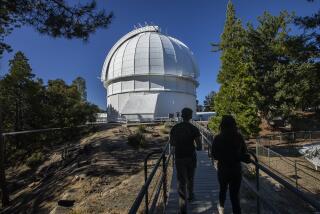Science / Medicine : Flawed Space Telescope Producing Some Results : Astronomy: After one year in space, the Hubble instrument is sending useful data about the brighter objects in the universe. Repairs are planned during a shuttle visit in 1993.
- Share via
Its vision is flawed and it is a little jittery, but the Hubble Space Telescope celebrated its first birthday last week, and its creators would like the world to know that it is producing scientific results.
“A lot of people have the idea it’s dead and useless,” said Ed Weiler, project scientist. On the contrary, he said, the $1.5-billion instrument is now spending more than half its time “doing science.”
The telescope was carried into orbit aboard a space shuttle last April 24 and deployed the next day. Scientists were stunned a short time later when they learned that the telescope’s seemingly perfect primary mirror had been ground incorrectly, making it impossible to focus the instrument.
Since that time, scientists and engineers with the National Aeronautics and Space Administration have learned to live with the problem, and the instrument has addressed some of the fundamental questions it was supposed to answer.
Weiler said that the Hubble has determined the distance to the Milky Way’s nearest neighbor, a sister galaxy called the Large Magellanic Cloud. The Hubble has found that the Large Magellanic Cloud is 169,000 light years away, within a margin of error of 5%, Weiler said. In the past, the margin of error was 20% to 25%, he said.
That measurement is important, he said, because it is the first step in the process of determining the size and age of the universe, two of the most fundamental questions in cosmology.
The biggest disappointment has been the telescope’s inability to focus on extremely dim objects in the outer reaches of the universe. That is probably the goal that had most fascinated the public because it was billed as a look back to the beginning of time, but it cannot be done because of the flawed mirror.
Instead, the telescope has concentrated on brighter objects, and the record has been impressive, Weiler said.
The images of bright objects can be enhanced with computers, he said, and “we can achieve the desired resolution,” or sharpness.
The telescope still falls short of expectations, and NASA is planning to make several repairs during a shuttle visit in 1993. Astronauts will spend 2 1/2 days outside the shuttle working on the telescope, according to Joseph Rothenberg, associate director of the project at the Goddard Space Flight Center in Greenbelt, Md.
The astronauts will replace the telescope’s primary instrument, a wide-field camera, with one that has been engineered to compensate for the Hubble’s flawed mirror. They will also replace the Hubble’s solar panels, which supply the electricity to run the instruments. The present panels cause the telescope to vibrate because of temperature changes when it passes from sunlight to shadow.
Rothenberg said the vibrations have been minimized by reprogramming the craft’s flight computer, but now the computer is so overloaded that it would be very difficult to deal with any new emergencies. With new solar panels, “we could unload the flight computer,” he said.
NASA is also considering installing a device that would correct the flaw in the mirror for all four of the telescope’s primary instruments, but Rothenberg indicated that that plan may be in trouble. The device, called COSTAR for “corrected optics space telescope axial replacement,” consists of a series of lenses that would extend and stand between the mirror and each of the instruments.
The spacewalking astronauts will be limited in the amount of time that they will be permitted to work on the Hubble, and there may not be enough time to install the system after they complete other repairs, Rothenberg said. It is still under study.
The Hubble’s Faint Object Camera, supplied by the European Space Agency, is not scheduled for replacement, and that is the instrument that was designed to look farther into the universe than any other telescope had ever seen.
COSTAR might be able to restore the Faint Object Camera to its full capabilities, but if it cannot be installed it may be many more years before the Hubble Space Telescope will be able to fulfill some of its promises.






